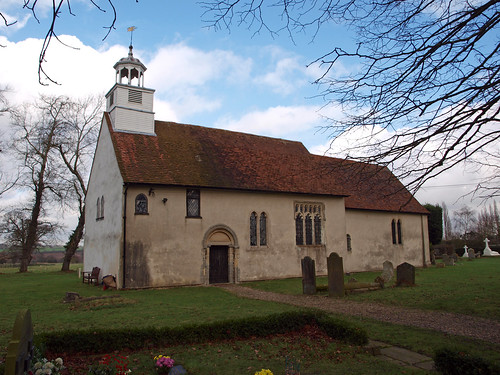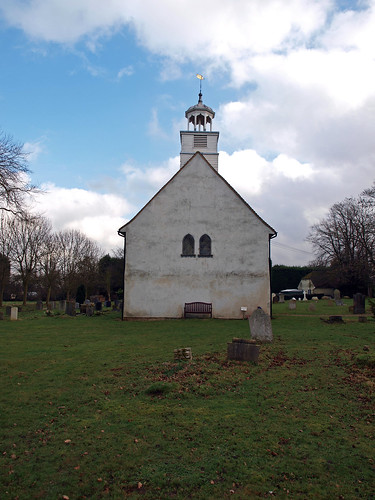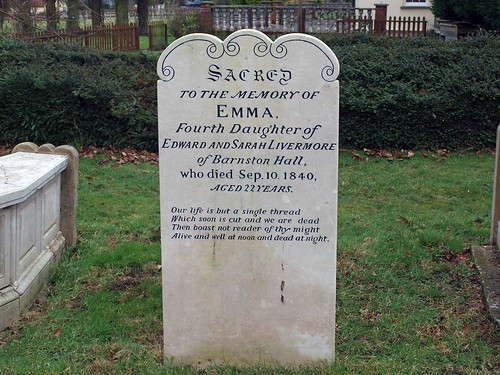In the churchyard is a whole series of Livermore headstones and tombs of Barnston Hall including four to Edward and Sarah Livermore's daughters: Martha Susannah died 3 April 1827 aged 14, Emma died 10 Sep 1840 aged 22, Jane died 30 May 1841 aged 19 and Maria who died 9 Dec 1841 aged 16. All four had verses which I found incredibly moving, Jane's reads:
The rising morning can't assure,
That we shall end the day
For death stands ready at the door
To take our lives away.
UPDATE: I revisited today (16th Feb 2012) after Simon Knott informed me that a key is now accessible even when the keyholder is absent. Sadly it's a disappointing interior but the piscina is fantastic and there's a nice south window by Burne Jones. Still I'm glad it's permanently accessible now.
CHURCH. Nave Norman with two N windows, one S window and a plain S doorway with one order of columns with scallop capitals. Chancel E.E. with one N lancet window and a fine Double Piscina of the type of Jesus and St John’s Colleges at Cambridge, that is with intersected round arches. The shafts have stiff-leaf capitals. The foliage runs on as a frieze behind the capitals towards the wall and fills the spandrels of the arches as well. C15 belfry with C18 cupola. PLATE. Cup and Paten on foot of 1712.
CHURCH. Nave Norman with two N windows, one S window and a plain S doorway with one order of columns with scallop capitals. Chancel E.E. with one N lancet window and a fine Double Piscina of the type of Jesus and St John’s Colleges at Cambridge, that is with intersected round arches. The shafts have stiff-leaf capitals. The foliage runs on as a frieze behind the capitals towards the wall and fills the spandrels of the arches as well. C15 belfry with C18 cupola. PLATE. Cup and Paten on foot of 1712.
BARNSTON. Up the hill and past some lovely white poplars we come to its church and hall, the one so small that it is not 20 feet wide, the other Elizabethan with fine windows, a central chimney with diagonal shafts, and in front a most noble elm towering up 100 feet. The church has a Norman nave, a Norman chancel rebuilt by the 13th century men, and a Norman doorway containing an ancient door with medieval hinges. One of the original narrow windows still lights up an old choir gallery, and outside other windows are quaint 15th century heads. From the 17th century the village has an oak chest, a carved communion table, and a tiny poor-box with many locks. Moulded timbers 500 years old rise from the nave to support a turret with a weathervane. A monument with three bright shields reminds us of Robert Scott, who was Dean of Rochester and came to lie here in 1620; and there is a family window to the Livermores of last century, a tribute to 15 of them, from little Martha who died in 1827 to an old lady who died in 1893. Another window has a few coloured bits from the 14th century among its modern glass. But the treasure of Barnston is its ancient piscina, the earliest double one known. It was made about 1200, and looks like a piece cut from a beautiful interlaced arcade.
Perhaps I did miss out after all.
Flickr set.
Simon K.
A deliciously set rustic church away from the nearest road. The interior is a bit of a disappointment, being thoroughly scoured, but the double piscina is outstanding of its kind.
Perhaps I did miss out after all.
Flickr set.
Simon K.
A deliciously set rustic church away from the nearest road. The interior is a bit of a disappointment, being thoroughly scoured, but the double piscina is outstanding of its kind.



No comments:
Post a Comment